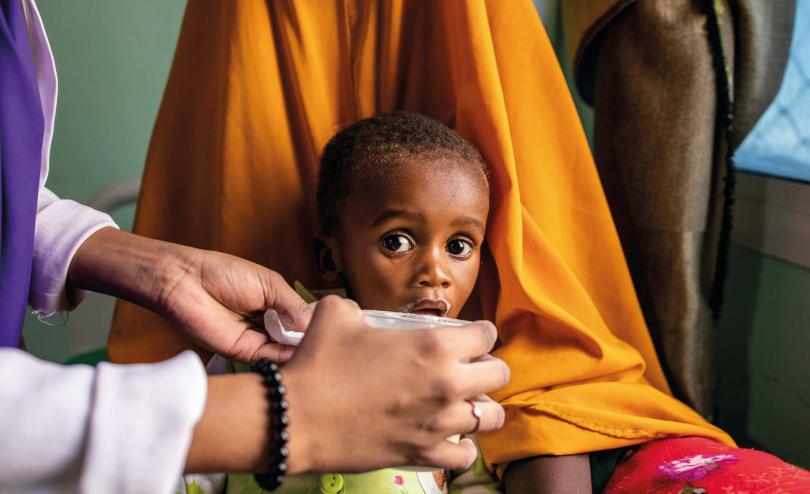More than 5.7 million children under five on the brink of starvation across the world

Save the Children launches largest ever appeal to help prevent hundreds of thousands of children from dying of hunger
With an estimated 5.7 million children under five on the brink of starvation across the globe, the world is facing the biggest global hunger crisis of the 21st century, Save the Children warned. A further 13 million children under 18 are facing extreme food shortages, the organisation said.
For the first time in decades, child hunger and malnutrition is on the rise, Save the Children said, with many families and communities struggling to provide their children with enough nutritious food.
A deadly combination of COVID-19, conflicts, and the impacts of climate change have pushed hunger and malnutrition levels to a record global high. Without urgent action, we could see thousands of children starving to death, reversing decades of progress, Save the Children warned.
In Syria, hunger levels rose by 56 percent between 2019 and the end of 2020, with two in three people in the country needing food or livelihood support. In Burkina Faso and Yemen, hunger levels rose by almost 10 percent. In Afghanistan, almost one in two children under five (3.1 million children) are facing acute malnutrition and need life-saving treatment.
Inger Ashing, CEO of Save the Children, said:
"Storms, floods, droughts, wars and the COVID-19 crisis have deeply impacted harvests, livestock, food prices and people’s livelihoods. But in today’s world, where there is enough food to feed every child and adult if we distribute it fairly, it is outrageous that millions face malnutrition and starvation. We have an opportunity to save many of these children, but we need to act now.”
To stop a disaster from unfolding further, Save the Children is launching the largest ever appeal in its history, aiming to raise $130 million in the coming months.
Hasna*, 23, is a young Syrian mother who had to flee her home in northeast Syria. She and her 18-month-old son Majad* are both malnourished:
“Sometimes, when I breastfeed my son, my milk isn’t enough for him. I therefore give him some rice or bulgur. There is nothing else I can feed him [like] fruit or meat.”
“I started seeing his health getting bad. They measured his arm and they said he had malnutrition. They measured mine as well and said I had malnutrition also. There was nothing I could do. I came back to the tent and started crying.”
In crises, children are always the most vulnerable. Without adequate nutritious food, children cannot develop as they should and are at a high risk of acute malnutrition. This can lead to stunting or death, with irreversible damage to a child’s physical and cognitive development.
Save the Children’s warning was triggered after analysing Integrated Phase Classification (IPC) data, looking at the number of children in the two highest levels of acute food insecurity. According to the analysis:
- The Democratic Republic of Congo has the highest number of children under five who are facing emergency levels of food shortages: 1.1 million children.
- In Yemen, almost 700,000 children under five face critical food shortages and in Afghanistan, almost half a million children are facing extreme hunger.
- This includes an estimated 41 million people experiencing IPC4, which means they are only one step away from famine.
- A further 150 million people could be pushed into extreme poverty by the end of this year alone.
- In 2020, 45 million children under the age of five were wasted. Without action, an additional 9.3 million more children could suffer wasting.
Save the Children said that even without famines being officially declared, many more children are dying from diseases such as pneumonia, diarrhea and malaria as a direct impact of extreme food insecurity and malnutrition. These are largely preventable diseases if world leaders and humanitarian organisations act swiftly.
Ms Ashing continued: “Our teams on the ground are seeing the number of malnutrition cases rise by the day. No child should ever go hungry. We cannot repeat the mistakes of the 2011 drought in the Horn of Africa, when up to 260,000 people died, many of them children.”
“There’s no vaccine for hunger, but there is a solution if we act now. Governments have to step up, honour their commitments, and do their part before it becomes a death sentence for so many children and adults."
Save the Children is calling on governments to fully fund humanitarian response plans, and support social protection schemes and health and nutrition services for children, including the treatment of acute malnutrition. We’re urging donors to prioritise humanitarian cash and voucher assistance for families, and to prioritise the increased risks of violence—particularly gender-based violence—caused by the COVID-19 pandemic. The organisation also urges influential governments to push for humanitarian access in all contexts, so all children can receive the support they need.
To truly put an end to global hunger and the malnutrition crisis, however, the international community must address the root causes of food and nutrition insecurity. Mitigating the worst effects of COVID-19 is just part of the solution, Save the Children said. Only by putting an end to global conflict, tackling changing climate and food systems, and building more resilient systems and communities will we be able to ensure the same warnings do not ring out again in the coming years.
For Save the Children’s appeal, please see here.
Notes to editors:
- The Integrated Phase Classification (IPC) is an internationally recognised famine early-warning system, based on a scale from one (minimal food stress) to five (catastrophe/famine).
- To calculate the number of children under five and under 18 years old on the brink of starvation, Save the Children used the number of people in IPC4 or higher in 36 countries or areas for which IPC data is available, and cross checked it with the UN’s population data. On average, 14.1 percent of the population in these countries or areas are children under five, and another 31.6 percent is between 5 and 18 years old. We applied these percentages to the number of 41 million people living in the highest food insecurity levels.
For more information or spokespeople, feel free to reach out:
- Rik Goverde, rik.goverde@savethechildren.org / +44 (0) 7732 602 301
- During out of office hours: media@savethechildren.org.uk / +44 7831 650 409
- North West Syria, Karma* https://www.contenthubsavethechildren.org/Package/2O4C2SCXNN11
- North West Syria, Azmi* https://www.contenthubsavethechildren.org/Package/2O4C2SCIBQ1B
- North East Syria, Majed* https://www.contenthubsavethechildren.org/Package/2O4C2SCIB8Q4




